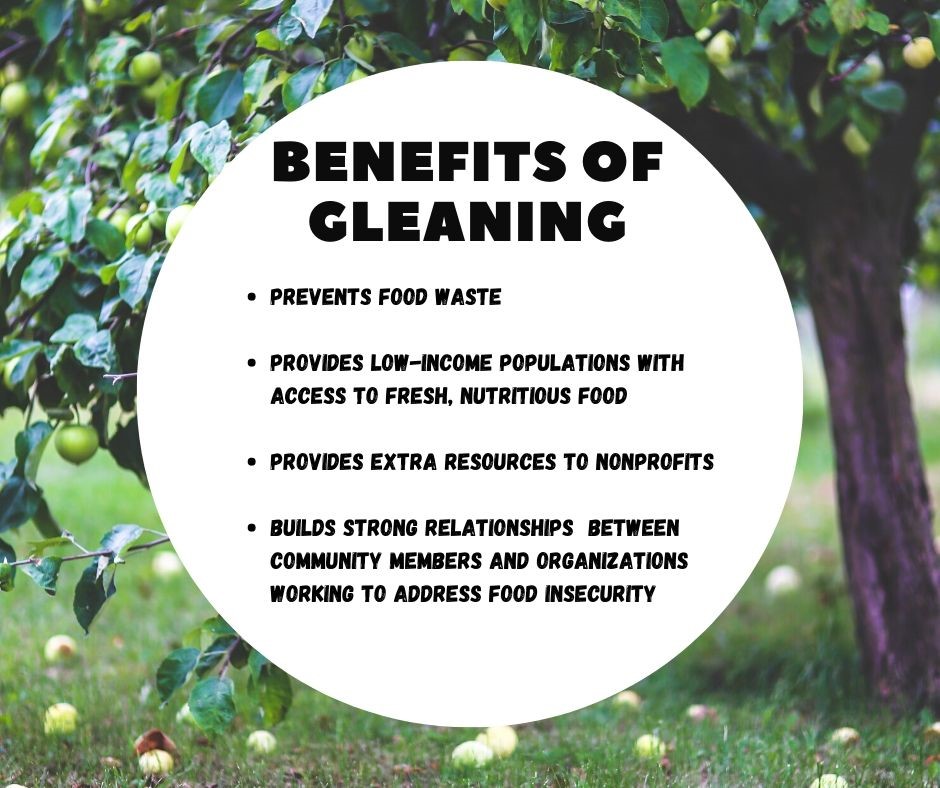
According to the 2023 Community Health Assessment of Yellowstone County, conducted by the Healthcare Alliance of Billings Clinic, RiverStone Health, and St. Vincent Healthcare:
- 9.6% of the population in Billings has been identified as experiencing poverty.
- 21.3% of Yellowstone County residents have low food access, meaning they do not live near a supermarket or grocery store.
- 21.8% of community residents are determined to be “food insecure”, having run out of food in the past year and/or been worried about running out of food.
Community gardens have been established over the years around the city to address food insecurity, and to take this mission a step further the Parks and Recreation Department began planting fruit-bearing trees and plants as a community resource.
The Parkland Gleaning Project was formed in 2018 through the collaborative efforts of the Billings Metro VISTA Project and the Parks and Recreation Department. In 2023, fruit bushes were also added to parks for berry gleaning.
Goal
These fruit trees and berry bushes are a public food resource. Gleaning is defined as the collection of excess fresh food from resources in the community and the distribution of it to those in need. Through the development of the Parkland Gleaning Project, the Billings Parks and Recreation Department wants to increase awareness of this free resource within the park system. Gleaning from public lands simultaneously helps to address the pressing issues of food insecurity and malnutrition in low-income neighborhood as well as the global effect of food waste and resource consumption.
All of the Billings Parks and Recreation’s fruit trees have been mapped on FallingFruit.org. This website is an editable database through which anyone can map food-producing trees around the country and the world. The website was created as a resource for urban foraging and for people to reconnect with the land. The berry gleaning locations are described below in Centennial, Pioneer, Primrose, and Rose Parks.
Parkland Gleaning Parks
The parks listed below are the primary 7 parks included in the Parkland Gleaning Project. However, if you use FallingFruit.org, you will see that many other parks and public areas in Billings also contain fruit-producing trees. You can filter the map on Fallingfruit.org by park/area or by fruit type.
Comanche Park
In October 2018, the HDR Green Team dedicated their time to planting 12 fruit-producing trees and shrubs in Comanche Park, such as dwarf cherry shrubs, chokecherries, and pears. These fruit-bearing trees are located in the southeast corner of the park.

Centennial Park
Centennial Park also aronia berries (or chokeberries) for gleaning near the eastern entrance to the dog park.

Highland Park
For The Kampgrounds of America’s (KOA) United Way Day of Caring, they dedicated their time to planting a variety of fruit-bearing trees in Highland Park, such as Honey Crisp, Red Macintosh apples, and Toka Plums. These fruit bearing trees are located in the southwest corner of the park.

Kings Green Park
In May 2020, volunteers from Downtown Rotary Club dedicated their time to planting 13 trees in Kings Green Park. These fruit-bearing trees are located just west of Kings Green Drive.

Lillis Park
The Girl Scouts of America and their families dedicated their time to planting a variety of fruit-bearing trees in Lillis Park, such as apples, plums, and cherries. These fruit bearing trees are located on the corner of Parkview Drive and Lillis Lane, toward the north side of the park.

Optimist Park
In May 2020, the HDR Green Team dedicated their time to planting 15 fruit-bearing trees in Optimist Park, such as apples, pears, and plums. These fruit-bearing trees are located on the western edge of the park.

Primrose Park
In October 2020, volunteers from Harvest Church, as well as some neighborhood volunteers dedicated their time to plant 15 fruit-bearing trees in Primrose Park, such as apples, pears, cherries, and plums. These fruit-bearing trees are located in the northwest corner of the park.

Primrose Park also has aronia berries (or chokeberries) for gleaning near the playground in the southwest corner of the park.

Pioneer Park
Pioneer Park has a berry patch for gleaning, which includes elderberries, service berries and strawberries. The bushes are planted on the east side of the park.


Rose Park
In Spring 2018, volunteers from Downtown Rotary Club dedicated their time to planting a variety of fruit-bearing trees in Rose Park, such as Honey Crips and Sweet Sixteen apples, and plums. These fruit-bearing trees are located on the northwest edge of the park, by the horseshoe pit.

Rose Park also has aronia berries (or chokeberries) for gleaning inside the pool area in a planter bed.

Volunteer Opportunities
We have a few different volunteer opportunities available within the Parkland Gleaning Project. If you have any questions or are interested in volunteering, please contact millironj@billingsmt.gov.
Opportunities include harvesting and food distribution.
Before starting any project with us, we ask that you watch this video.
Recipes
Here are some fun recipes to try as you go about your foraging adventures!

